March 23, 2015
A while back over at Get-Fit Guy’s Quick & Dirty Tips I wrote a two-part series telling you how to effectively target 7 trouble spots. It was such a popular series I decided to combine them into a single article here on Ben Greenfield Fitness. Trouble spots are areas on your body that don't look the way you want them to. These can be body parts that are simply too fat or skinny, not curvaceous or toned enough, or simply too weak and prone to injury – the type of troublesome issues that really bug you about your body! Have you ever wished you could just walk into a gym and get a customized list of the very best exercises to target your specific trouble spots? Consider this post your go-to guide for the best butt, hip and thigh exercises, the best calf exercises, the best chest exercises, the best shoulder exercises, the best back exercises, the best arm exercises, and the best ab exercises.
——————————-
How to Find Out How Much A Muscle Contracts
Sports and exercise scientists utilize many different tools and methods to help them determine how much a muscle contracts during a specific movement, how many calories a specific movement burns, or how much stress is placed on a joint during a movement. One of the most popular and effective tools used to measure muscle utilization is electromyography, also known as “EMG.” EMG simply measures the electrical activity produced by muscles, and is performed using a special instrument called an electromyograph. The electromyograph creates a record called an electromyogram, which scientists then use to quantify the strength or quality of a muscle contraction. EMG signals can also be used to analyze medical abnormalities, the activation level of different areas of a muscle, the order in which muscles are recruited, and biomechanical abnormalities from injuries or poor movement patterns. So what can EMG tell us about the best exercises for 7 popular trouble spots? Many studies have used EMG to study the extent to which certain exercises activate certain body parts. So if we know which exercises cause maximum activation of a specific body part, we can use those exercises to create the best workout plan for that specific body part (or trouble spot)! Below, you will find a list of trouble spots and the best exercises for each.
——————————-
Butt, Hip, and Thighs
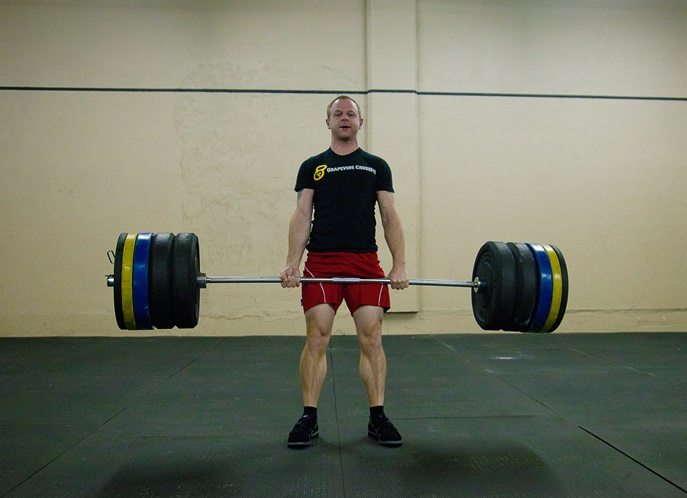 In a previous Get-Fit Guy newsletter, I revealed that 2 different exercises cause your glutes to grunt the hardest:
In a previous Get-Fit Guy newsletter, I revealed that 2 different exercises cause your glutes to grunt the hardest:
- Prone bent leg hip extension against manual resistance. Yep, that’s a mouthful. Basically, the move involves getting into a crawl position with hands and feet on the ground and then kicking out behind you with one leg – against a partner who is manually resisting your kicking force. Of course, you could also do this exercise against resistance such an elastic band, as I describe in the article “How to Tone Your Butt,” but it’s not quite as effective as having a partner resist your kicking force.
- Standing butt squeezes with a wide stance and feet turned out. This one is a bit hard to describe, but I’m going to give you the description from one of my favorite butt-experts – Bret Contreras, who says:
“From a standing position, take a moderate to wide stance and flare the feet out slightly. Now squeeze the glutes as hard as possible for 30 seconds. Make “fists” to increase the neural drive through irradiation. Just do this one time.” Want even more butt tips? Then check out the episode “How to Get A Better Butt.” In addition to your butt, it’s important to target your hips and thighs. It turns out the very best 2 exercises for activating your hips and thighs are the deadlift, in which you simply lift a heavy weight from the ground, and the glute ham raise, which is a special apparatus at the gym that is also known as the low back extension. For the deadlift (which I also list as one of my 2 favorite exercises for getting a flat stomach), the basics are simple. You just pick a weight such as a barbell, dumbbell, kettlebell or any other heavy object off the ground while using good form that relies on your hips and legs, and not your lower back. For the glute ham raise or low back extension, begin by adjusting the equipment to fit your body. With your feet against the footplate in between the rollers as you lie face down, your knees should be just behind the pad. Keep your back arched as you begin the movement by flexing the knees and driving your toes into the foot plate as you do so. Keep your upper body straight, and continue until your body is upright, then return to the starting position, keeping your descent under control.
——————————-
Calves
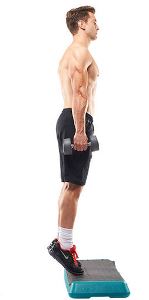 Now that you know how to target your butt, hips and thighs, there’s one other section of your legs to worry about: your calves. Believe it or not, working your calves is not rocket science. The most effective exercise for your calves is the standing calf raise – which simply involves rising up onto your tippy-toes while you’re in a standing position. The beauty of this exercise is that you can do it anywhere – while taking a shower, brushing your teeth, waiting in line at the grocery store, or even while doing other exercises at the gym – such as doing a standing calf raise while you press dumbbells overhead. For even more activation, you can stretch your calves prior to going up onto your tip toes. To do this, stand on the edge of a stair, box or other platform and dip your heels as low as possible before contracting your calf muscles and rising up onto your toes. Go back slowly to the starting position as you breathe in by lowering your heels as you bend the ankles until calves are stretched. You can also make this exercise more difficult by adding weight, which is often done by using a weighted standing calf raise machine at a gym.
Now that you know how to target your butt, hips and thighs, there’s one other section of your legs to worry about: your calves. Believe it or not, working your calves is not rocket science. The most effective exercise for your calves is the standing calf raise – which simply involves rising up onto your tippy-toes while you’re in a standing position. The beauty of this exercise is that you can do it anywhere – while taking a shower, brushing your teeth, waiting in line at the grocery store, or even while doing other exercises at the gym – such as doing a standing calf raise while you press dumbbells overhead. For even more activation, you can stretch your calves prior to going up onto your tip toes. To do this, stand on the edge of a stair, box or other platform and dip your heels as low as possible before contracting your calf muscles and rising up onto your toes. Go back slowly to the starting position as you breathe in by lowering your heels as you bend the ankles until calves are stretched. You can also make this exercise more difficult by adding weight, which is often done by using a weighted standing calf raise machine at a gym.
——————————-
Chest
The best exercises for your chest (affectionately called by fitness geeks “the pecs”) are the dumbbell bench press and weighted dips. 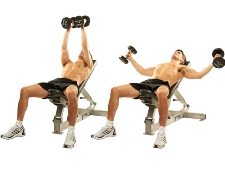 For the dumbbell bench press, you lie down on a flat bench with a dumbbell in each hand with your arms flexed at 90 degrees. Then, as you breathe out, use your chest muscles to push the dumbbells up as you extend your arms. Get close to locking your arms at the top of the lift and squeeze your chest, hold for a second, and then begin coming down slowly. Ideally, lowering the weight should take about twice as long as raising it. For weighted dips, place a bench or chair behind your back and another bench or chair in front of you. With the benches (or chairs) perpendicular to your body, hold on to one bench on its edge with your arms fully extended, your hands close to your body and separated at shoulder width. Meanwhile, your legs should be extended forward on top of the other bench. Your legs should be parallel to the floor while your torso is perpendicular to the floor. Then put a dumbbell or any other weight on your lap (this works best if you have a partner put the weight in your lap) and slowly lower your body by bending at the elbows until you lower yourself far enough to where there is an angle that is slightly less than 90 degrees between the upper arm and the forearm. Then simply push yourself back to the starting position while exhaling.
For the dumbbell bench press, you lie down on a flat bench with a dumbbell in each hand with your arms flexed at 90 degrees. Then, as you breathe out, use your chest muscles to push the dumbbells up as you extend your arms. Get close to locking your arms at the top of the lift and squeeze your chest, hold for a second, and then begin coming down slowly. Ideally, lowering the weight should take about twice as long as raising it. For weighted dips, place a bench or chair behind your back and another bench or chair in front of you. With the benches (or chairs) perpendicular to your body, hold on to one bench on its edge with your arms fully extended, your hands close to your body and separated at shoulder width. Meanwhile, your legs should be extended forward on top of the other bench. Your legs should be parallel to the floor while your torso is perpendicular to the floor. Then put a dumbbell or any other weight on your lap (this works best if you have a partner put the weight in your lap) and slowly lower your body by bending at the elbows until you lower yourself far enough to where there is an angle that is slightly less than 90 degrees between the upper arm and the forearm. Then simply push yourself back to the starting position while exhaling.
——————————-
Shoulders
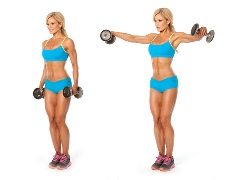 When it comes to your shoulders, you’d think a basic overhead shoulder press would be the best way to go, but it turns out that to get a nice, toned triangular look in your shoulders, you actually need to do 2 types of “raises” – both a lateral raise and a rear raise. You need to perform 2 different exercises because the deltoid muscles in your shoulders a.k.a. “delts” are actually comprised of 3 distinct sets of muscle fibers – each of which can be targeted with different moves. So you need to come at your shoulder from a variety of different angles. For a lateral delt raise, simply stand with your arms at your side holding a weight such as a dumbbell in each hand, then, keeping your arms as straight as possible, raise the dumbbells out to the side until they are parallel to your shoulders. Finally, slowly lower the weights back to the start position. The movement for a rear delt raise is very similar, but this time, you’re bent over with your butt out behind you and a straight back, and you start with the dumbbells hanging below your chest. Then you raise the dumbbells (as if your arms were airplane wings) towards the ceiling while squeezing your shoulder blades together.
When it comes to your shoulders, you’d think a basic overhead shoulder press would be the best way to go, but it turns out that to get a nice, toned triangular look in your shoulders, you actually need to do 2 types of “raises” – both a lateral raise and a rear raise. You need to perform 2 different exercises because the deltoid muscles in your shoulders a.k.a. “delts” are actually comprised of 3 distinct sets of muscle fibers – each of which can be targeted with different moves. So you need to come at your shoulder from a variety of different angles. For a lateral delt raise, simply stand with your arms at your side holding a weight such as a dumbbell in each hand, then, keeping your arms as straight as possible, raise the dumbbells out to the side until they are parallel to your shoulders. Finally, slowly lower the weights back to the start position. The movement for a rear delt raise is very similar, but this time, you’re bent over with your butt out behind you and a straight back, and you start with the dumbbells hanging below your chest. Then you raise the dumbbells (as if your arms were airplane wings) towards the ceiling while squeezing your shoulder blades together.
——————————-
Back
Your back is comprised of many different muscles, but when it comes to your posture, how you look in a t-shirt or swimsuit, or how you look with your shirt off, there are 3 specific muscle groups that you really need to target: your upper trapezius a.k.a. “traps,” your mid-trapezius, and your latissimus dorsi a.k.a. “lats.” 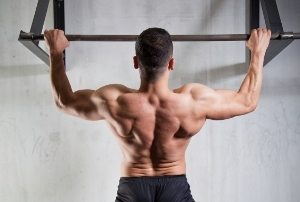 The trapezius is a large muscle that extends from the back of your head all the way down to your mid-back, and is responsible for moving your shoulder blades and supporting your arms. Your latissimus is the larger, flat “wing-shaped” muscle that extends from your spine all the way out to underneath your armpits. One of its primary purposes is to engage in upper body pulling. A nice, toned trapezius and latissimus dorsi form the foundation of a good-looking back! Nothing beats a basic shoulder shrug for the upper traps. This exercise is as simple as it sounds. Simply stand with a weight at your side and shrug – with a goal of driving your shoulders all the way up to reach the bottom of your ears. Hold for 1 or 2 seconds, then lower. For the mid-traps, you’ll want to do bent-over rows. There are many versions of bent-over rows, but my favorite is to simply bend over with a straight back, in a lunging position, with your body weight supported over both legs. In this position, you should be holding a dumbbell in one hand. Then simply row that dumbbell as high as possible, as if you were starting a lawnmower. Hold for 1 or 2 seconds, then lower. Finally, for your lats, there is nothing better than a pull-up or a pull-down (and I am a firm believer that everyone should have a pullup bar like this hanging in the door frame somewhere in their home). For either of these exercises, try to grip the bar that you are pulling towards your chest with a “thumbs-off” grip, because this will activate more of your back muscles.
The trapezius is a large muscle that extends from the back of your head all the way down to your mid-back, and is responsible for moving your shoulder blades and supporting your arms. Your latissimus is the larger, flat “wing-shaped” muscle that extends from your spine all the way out to underneath your armpits. One of its primary purposes is to engage in upper body pulling. A nice, toned trapezius and latissimus dorsi form the foundation of a good-looking back! Nothing beats a basic shoulder shrug for the upper traps. This exercise is as simple as it sounds. Simply stand with a weight at your side and shrug – with a goal of driving your shoulders all the way up to reach the bottom of your ears. Hold for 1 or 2 seconds, then lower. For the mid-traps, you’ll want to do bent-over rows. There are many versions of bent-over rows, but my favorite is to simply bend over with a straight back, in a lunging position, with your body weight supported over both legs. In this position, you should be holding a dumbbell in one hand. Then simply row that dumbbell as high as possible, as if you were starting a lawnmower. Hold for 1 or 2 seconds, then lower. Finally, for your lats, there is nothing better than a pull-up or a pull-down (and I am a firm believer that everyone should have a pullup bar like this hanging in the door frame somewhere in their home). For either of these exercises, try to grip the bar that you are pulling towards your chest with a “thumbs-off” grip, because this will activate more of your back muscles.
——————————-
Arms
To get nice arms – or to justify wearing that “Welcome to The Gun Show” t-shirt, you’ll want to work both your biceps and your triceps.  The very best exercise for the biceps (the front of your arms) is similar to one of the best exercises for your back: a chin-up. So what’s the difference between a pull-up and a chin-up? A pull-up is performed with your knuckles facing you, while a chin-up is performing with you knuckles turned away from you. If you can’t do a chin-up, just do a cable pull-down with your knuckles turned away from you, also known as a cable underhand pull-down. For your triceps (the back of your arms), triceps extensions are the best exercise. A simple version of the triceps extensions exercises that you can perform with minimal equipment is a standing overhead triceps extension. For a standing overhead triceps extension, stand with your elbows overhead and a dumbbell (or any other weight) grasped in both hands, and lower the weight back behind your head by flexing your elbows. Try to get your elbows bent to 90 degrees. Then raise the weight back over your head by extending your elbows.
The very best exercise for the biceps (the front of your arms) is similar to one of the best exercises for your back: a chin-up. So what’s the difference between a pull-up and a chin-up? A pull-up is performed with your knuckles facing you, while a chin-up is performing with you knuckles turned away from you. If you can’t do a chin-up, just do a cable pull-down with your knuckles turned away from you, also known as a cable underhand pull-down. For your triceps (the back of your arms), triceps extensions are the best exercise. A simple version of the triceps extensions exercises that you can perform with minimal equipment is a standing overhead triceps extension. For a standing overhead triceps extension, stand with your elbows overhead and a dumbbell (or any other weight) grasped in both hands, and lower the weight back behind your head by flexing your elbows. Try to get your elbows bent to 90 degrees. Then raise the weight back over your head by extending your elbows.
——————————-
Abs
A simple search for “abs” over at the QuickAndDirtyTips website will reveal a number of articles I’ve written on that ever-elusive goal of a flat stomach or a six-pack abs, including “How to Get Abs Like Magic Mike” and “How To Get Washboard Abs – Fast!” But what does electromyography reveal about maximum activation of abdominal muscle tissue? It turns out that the 3 exercises that maximally stimulate your stomach are hanging leg raises, weighted crunches, and ab wheel rollouts. For a hanging leg raise, grasp and hang from a bar with slightly wider than shoulder width overhand grip, then raise your legs by flexing hips and knees until your hips are completely flexed or knees are well above hips.  For a weighted crunch, simply hold a weight (a barbell plate, dumbbell, or medicine ball works quite well) to your chest and perform a crunch. And finally, an ab wheel rollout uses that funky contraption that looks like some kid accidentally left their tricycle wheel at the gym. An ab wheel is basically a small wheel with a handle through the center of it (I've been using one called an “Ab Carver” by Perfect Fitness). To do an ab-wheel rollout, begin by kneeling on the floor (you’ll want a mat under your knees – trust me)! Grasp the handles on either side of the wheel with an overhand grip, then keeping your arms straight, roll the wheel out as far as possible as you extend your body forward. This is harder than it sounds! Next, bring your body back up to the starting position by flexing your abs. Warning: Doing this exercise properly is not for the faint of heart!
For a weighted crunch, simply hold a weight (a barbell plate, dumbbell, or medicine ball works quite well) to your chest and perform a crunch. And finally, an ab wheel rollout uses that funky contraption that looks like some kid accidentally left their tricycle wheel at the gym. An ab wheel is basically a small wheel with a handle through the center of it (I've been using one called an “Ab Carver” by Perfect Fitness). To do an ab-wheel rollout, begin by kneeling on the floor (you’ll want a mat under your knees – trust me)! Grasp the handles on either side of the wheel with an overhand grip, then keeping your arms straight, roll the wheel out as far as possible as you extend your body forward. This is harder than it sounds! Next, bring your body back up to the starting position by flexing your abs. Warning: Doing this exercise properly is not for the faint of heart!
——————————-
Summary
I put out a lot of content over at Get-Fit Guy, I realize that so much information can be overwhelming to sift through, so I want to give you the easiest website to go to for navigating all the tips: just click here to check out all the Get-Fit Guy Episodes, including podcasts, podcast show notes, and previous Get-Fit Guy newsletter episodes. You’ll also see an iTunes button over there that lets you automatically subscribe in iTunes, along with a free newsletter sign-up option. And feel free to leave your questions, your comments, your feedback and your trouble spots below!





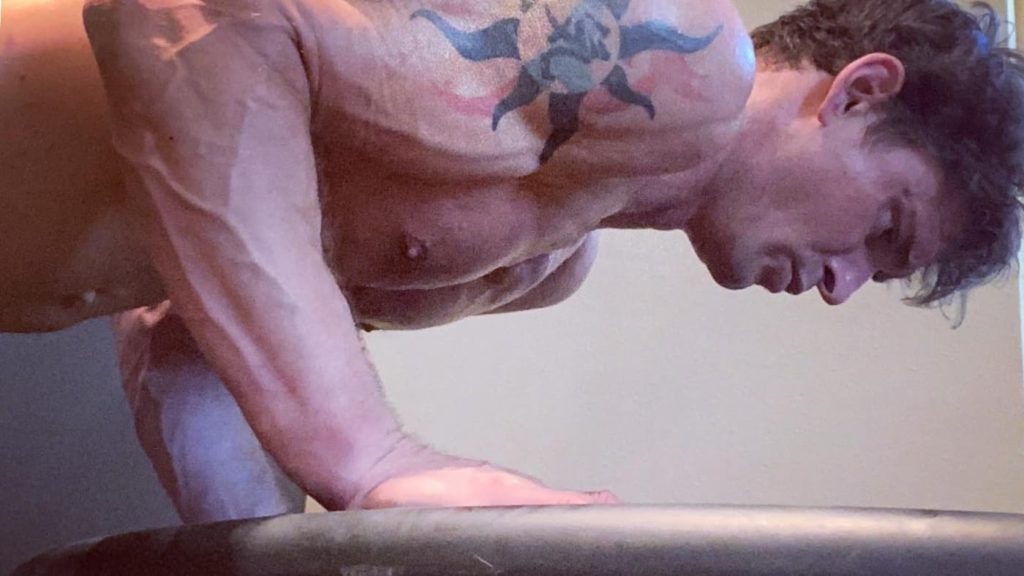
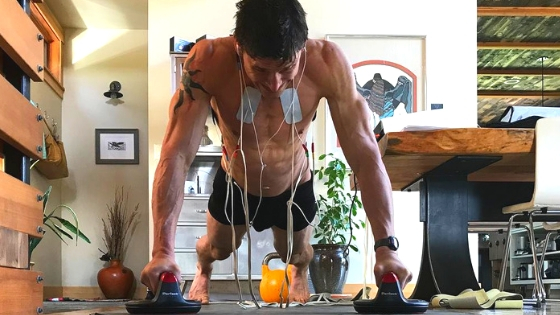






Thanks Ben. I’ve read that traditional chin ups put too much strain on the shoulders/elbows and that neutral grip chin/pull ups should be done instead. Curious to get your thoughts.
Totally not hte case IF when you are doing a standard/traditional pullup you are going out of your way to keep your shoulders squeezed back and you're not "kipping" or swinging/cheating. A proper, biomechanically sound pullup actually can heal shoulder and elbow issues. Just like anything though, it needs to be done with correct form (kinda like how bad squats hurt the knees but good squats help the knees).
Anything Specific for love handles?
I have a bunch of belly fat loss technique on the website! Take a look at this https://bengreenfieldfitness.com/2012/09/episo… and this https://bengreenfieldfitness.com/2014/12/day-l… and finally this https://bengreenfieldfitness.com/2013/10/fat-l…
Great stuff Ben, Short and to the point!
Hey Ben;
Per Dr. Stuart McGill aren't crunches to be avoided?
Thanks,
Dallan
Perhaps not completely avoided… but rather used in moderation. Have a look at this article I wrote a while ago – http://www.huffingtonpost.com/ben-greenfield/ab-w…